 |
 |
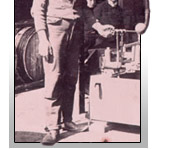
|
Photograph Collections The Maritime History Archive actively collects photographs which document the maritime industries of Newfoundland and Labrador. Photographs of vessels, trading or fishing in and around Newfoundland, and activities relating to the fishery make up the majority of the archive's photograph holdings. These are complemented by images of communities, buildings, events and most importantly, people. There are currently over 500 photograph collections, consisting of more than 20,000 images, the majority of which are dated within the 20th century. If you would like to have a high-resolution copy of any of these images for printing or publication, please contact the MHA's Research Desk at mhares@mun.ca. Copies cost $20.00 (CAD) each. (Note: Canadian residents must also pay the 15% HST.) Search the Public Photo Catalog The Captain Harry Stone Collection, donated to the MHA from 1994 onwards, is the largest photograph collection in the archive. It consists of over 5,100 identified images of ships and shipping in and around the coast of Newfoundland and Labrador throughout the 20th century. Captain Stone was appointed Harbour Master at St. John's in the early 1960s, and kept a photographic record of all the vessels entering the harbour. His collection also includes copies of historic photographs of aspects of the fishing industry, shipwrecks, sealing vessels, lighthouses, wharfs and stages, seafarers, fishermen and women and other topics relating to the maritime culture of Newfoundland and Labrador. Below are samples of the archive's photographic holdings. Captain Harry Stone Collection. Lighthouse at Lobster
Cove Head. PF-055.2-H07 
Captain Harry Stone Collection. [Gaultois], c. 1920. PF-55.2-I35. Photographer G.A. England. Original photograph, G.A. England Collection. Provincial Archives of Newfoundland and Labrador, A43-159 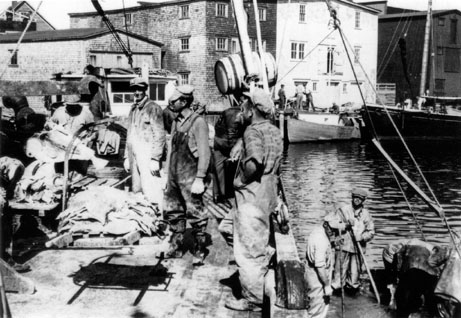
Wayne McPhail Collection. Fishermen washing fish, Grand Bank, Newfoundland PF-046.002 The town of Grand Bank on the Burin Peninsula was a major centre for the Bank fishery, prosecuted on the Grand Banks - the Continental Shelf which extends almost 200 miles from Newfoundland's southeast coast. The photograph above shows fishermen washing fish in pounds and hoisting it up onto the wharf of Grand Bank merchants Forward and Tibbo. The French islands of St. Pierre and Miquelon lie to the South of Newfoundland. During the prohibition era quantities of liquor was brought illegally from the Islands into the United States on the now-famous rum runners. In the photograph below men are putting the liquor into storage before loading it onto vessels for shipment. 
Captain Harry Stone Collection. St. Pierre - storing liquor before loading on runners. c. 1930. PF-001-1.H005b 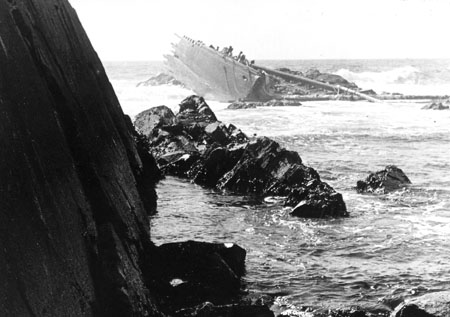
Captain Harry Stone Collection. Natalie [Nathaly] J. Nelson, Schooner wrecked at St. Pierre, October 5, 1923. PF-001-H76 The Natalie J. Nelson was a rum runner, owned and captained by Steven Fudge. She was built in 1903 in Essex, Maine and registered at St. John's, Newfoundland. She went aground on Black Rocks, Point Blanche, just south of St. Pierre, carrying 4,000 cases of whisky which were destined for delivery off the east coast of the USA. Coal was brought to Newfoundland from the mines at North Sydney, Cape Breton, on board schooners. The vessel pictured below was owned by A. Wareham Ltd. of Spencer's Cove. Spencer's Cove was one of many thriving communities in Placentia Bay which was resettled under the Government program in the 1960s. 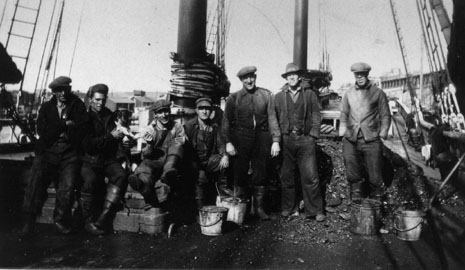 A. Wareham Ltd., Spencer's Cove Photographs. PF-013.015 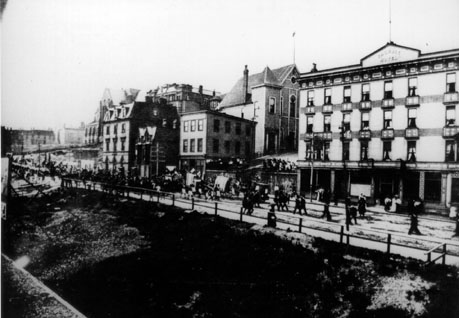 Captain Harry Stone Collection. Duckworth Street, St. John's, Nfld. c. 1910 PF-055.2-H034 This photograph of a parade on Duckworth Street shows the Crosbie Hotel, built in 1894 and the LSPU (Longshoremens' Protective Union) Hall, built in 1906. St. John's was totally devastated by fire in 1892, which left most of the business section in ruins and over 12,000 people homeless. The business sector suffered severe financial loss, leading to the closing of the two major banks, two years later. The open area in the foreground is evidence of some of the remaining damage caused by the fire. 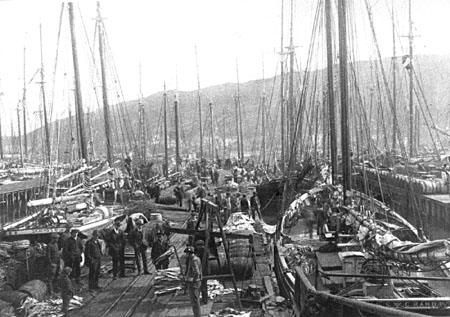 George M. Barr, photograph. Photographer, S.H. Parsons & Sons, St. John's. "A Slack day on the Premises of George M. Barr", PF-010 To the south of Duckworth Street, on the Water Front, the harbour is a forest of masts of trading vessels and fishing schooners. "A Slack Day on the Premises of George M. Barr" provides a brilliant image of St. John's harbour in the early part of this century. |
|||||||||||||||||||||||||||
© 2003 - 2012 Maritime History Archive, Memorial University |